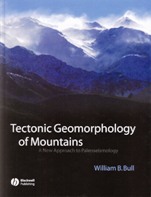Tectonic Geomorphology of Mountains - a new approach to paleoseismology

W B Bull
Published by: Blackwell Publishing
Publication date: September 2007
ISBN: 978-1-4051-5479-6
List price: £42.50
316 pp
www.blackwellpublishing.com
The key to this book is the subtitle – a new approach to paleoseismology - one of the new innovative subsets of geoscience that emphasises the multi-disciplinary nature of geological investigations. Paleoseismology seeks to understand and evaluate the record of prehistoric earthquakes through stratigraphic and geomorphic investigations, to enable better evaluation of hazards associated with future seismic events. This book presents tectonic knowledge within this new focus, and explores the impact of ‘scrunch and stretch’ processes on landscape development and the formation of distinctive tectonic landforms in mountainous environments.
The book contains six chapters, beginning with a comprehensive and well-written exposition on the problems of defining ‘uplift’ in relation to landscape response. The underlying conceptual basis for the book is outlined in Chapter 2 with specific emphasis on fluvial system interactions in active tectonic environments. This is an excellent review of fundamental geomorphic principles, which are clearly explained and discussed with respect to morphometric analysis, system thresholds and temporal responses.
The next three chapters introduce the main landform elements, such as mountain fronts and fault scarps associated with tectonic-fluvial processes, and include a novel attempt to synthesise this information to form diagnostic landscape classes. Using numerical descriptions of landforms and landscape morphology, this section presents a classification of ‘landscape assemblages’ with respect to relative tectonic activity, and is one of the more important aspects of this book. It could, however, been more clearly articulated with better definition of the proposed classes. In the final chapter, there is a change in focus towards paleoseismology and a change in geographic location from western North America to New Zealand. This is another important chapter containing new and important discussion on lichenometry and its use in dating coseismic rockfall events.
The book contains numerous excellent field examples to illustrate the concepts introduced in the text. It clearly relies on the author’s extensive field experiences with most of the examples drawn from western North America and New Zealand. There are many illustrations of present-day landscapes and explanatory diagrams, but with an unusual numbering system that divides individual figures into distinct parts. However, this is only a minor criticism in what is an excellent advanced textbook that should be widely read by all geologists interested in the interaction of active tectonics and landscapes.
Wishart A Mitchell, Department of Geography, University of Durham